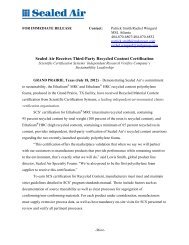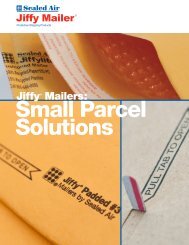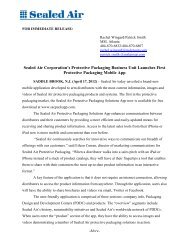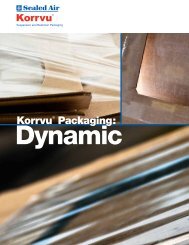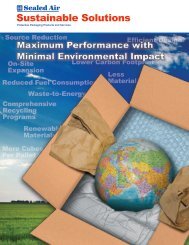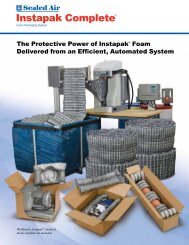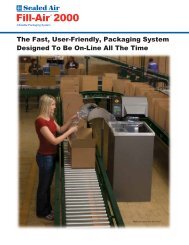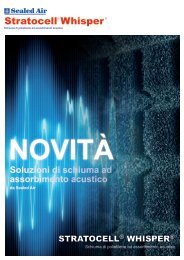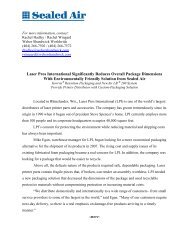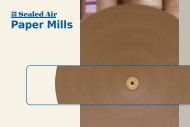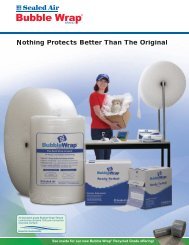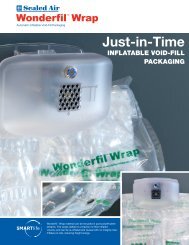Sealed Air Sheds Light On Davis Neon's Packaging - Protective ...
Sealed Air Sheds Light On Davis Neon's Packaging - Protective ...
Sealed Air Sheds Light On Davis Neon's Packaging - Protective ...
Create successful ePaper yourself
Turn your PDF publications into a flip-book with our unique Google optimized e-Paper software.
For more information, contact:<br />
Rachel Hadley / Rachel Wingard<br />
Weber Shandwick Worldwide<br />
(404) 266-7502 / (404) 266-7572<br />
rhadley@webershandwick.com<br />
rwingard@webershandwick.com<br />
<strong>Sealed</strong> <strong>Air</strong> <strong>Sheds</strong> <strong>Light</strong> <strong>On</strong> <strong>Davis</strong> Neon’s <strong>Packaging</strong><br />
<strong>Davis</strong> Neon Experienced 62 Percent Savings in Material Costs<br />
By Using <strong>Sealed</strong> <strong>Air</strong>’s Continuous Foam Tubes<br />
DANBURY, Conn. (June 26, 2007) – At a 155,000 square-foot facility in Heath<br />
Springs, S.C., <strong>Davis</strong> Neon Inc. – a leading wholesale neon-sign manufacturer – creates<br />
custom-made neon signs from raw materials for shipments worldwide. For Dave Lytle, shipping<br />
manager of <strong>Davis</strong> Neon, protecting the signs during shipment and saving on packaging-material<br />
costs are of the utmost importance.<br />
“We were using preformed polyethylene foam sheets which required a lot of storage<br />
space and time to unload from the trucks,” stated Lytle. “We were keeping our eyes open for an<br />
alternative packaging method which would provide comparable protection, yet reduce costs and<br />
increase productivity.”<br />
Due to his knowledge of the success <strong>Sealed</strong> <strong>Air</strong> has had using Instapak ® foam packaging<br />
with neon signs, Ray Hill, sales representative of PakSouth, contacted <strong>Davis</strong> Neon to inquire<br />
about its packaging methods. Hill met with Lytle to examine the company’s current packaging<br />
process and address Lytle’s concerns about packaging and shipment costs. After discussing<br />
possible solutions, Lytle agreed to use Instapak ® Continuous Foam Tubes made by the<br />
SpeedyPacker Insight ® system to package the neon signs.<br />
To produce continuous foam tubes (CFTs), the SpeedyPacker Insight ® system dispenses<br />
a mixture of “A” component and “B” component into a SpeedyPacker ® film bag. When mixed,<br />
the “A” and “B” components react with each other to create high-quality polyurethane packaging<br />
foam on demand. The CFT feature allows the SpeedyPacker Insight ® system to seal the bag in<br />
such a way that it produces small, tube-like shapes that can be placed where product protection is<br />
needed. The tubes can be contiguous or produced in series, with or without film spacing between<br />
them. The result is a “one-step” engineered package, made by the touch of a button. For even<br />
greater efficiency on the packaging line, packagers can make the continuous foam tubes in<br />
advance and store them for future use.<br />
-more-
<strong>Sealed</strong> <strong>Air</strong>/<strong>Davis</strong> Neon case study – page 2<br />
“We take great pride in packaging our signs so they arrive at their destinations in the<br />
same condition as they left the building,” stated Lytle. “The SpeedyPacker Insight ® system with<br />
Instapak ® CFTs seemed like it might provide the protection and cost savings we were seeking.”<br />
Emerging from the Dark<br />
Before the SpeedyPacker Insight ® system was installed at <strong>Davis</strong> Neon, <strong>Sealed</strong> <strong>Air</strong>’s local<br />
package design and development center provided pre-made Instapak ® CFT samples to determine<br />
if the packaging method would be the right choice for the neon signs. After packaging with the<br />
Instapak ® CFT samples and evaluating the results, Lytle decided to install a system for further<br />
testing. The system was installed in September 2006 and, for the next three months, <strong>Davis</strong> Neon<br />
conducted material-handling and cost-analysis testing.<br />
“We not only discovered the Instapak ® CFT solution provided more than enough<br />
protection to the signs during shipping, but we estimated the materials savings would be quite<br />
significant,” stated Lytle. “As a result, we decided to switch to the SpeedyPacker Insight ® system<br />
with Instapak ® CFT capability.”<br />
Turning on the <strong>Light</strong><br />
<strong>Davis</strong> Neon employees create custom-made wood crates for each neon sign with<br />
dimensions just large enough to house the sign, allowing for minimal movement. Out of<br />
110 employees, 11 operate the shipping department and are responsible for making the wood<br />
crates, packaging the signs and scheduling the shipments.<br />
“The SpeedyPacker Insight ® system with CFT capability can create numerous variations<br />
of foam bags and tubes, but we most often use 16-inch-wide tubes,” stated Lytle. “Since the<br />
Instapak ® CFTs can be made and saved for later use, we fill a large, rolling container with<br />
Instapak ® CFTs and transport them wherever they are needed to pack signs.”<br />
<strong>On</strong>ce the packaging department receives the neon sign components and creates the wood<br />
crate, the packager puts a layer of Instapak ® CFTs on the bottom of the crate to form a bottom<br />
pad. The first row-of-letters is placed “face down” onto the foam tubes and Bubble Wrap ®<br />
cushioning is placed on the backs, in between and around the sides of the letters to provide<br />
surface protection and prevent abrasion of the letters against the crate. Then the second row-ofletters<br />
is placed on top of the Bubble Wrap ® cushioning “face up,” so the letters are back-toback.<br />
The packager puts Instapak ® CFTs on top of the letters, and ties down boards over the<br />
Instapak ® CFTs to keep the letters from moving during shipping. Lastly, the packager attaches<br />
the lid to the crate, and the crate is shipped to the customer on dedicated trucks.<br />
-more-
<strong>Sealed</strong> <strong>Air</strong>/<strong>Davis</strong> Neon case study – page 3<br />
Illuminating Results<br />
Before implementing the SpeedyPacker Insight ® system with Instapak ® CFTs, the<br />
packagers used preformed polyethylene foam sheets. Each sheet of polyethylene foam had to be<br />
cut by hand to fit the crate for the bottom pad and top layer, as well as to fit in between and<br />
around the letters.<br />
“The preformed polyethylene foam sheets took a long time to cut, were expensive and<br />
produced significant material waste,” stated Lytle. “During the testing phase of the new<br />
packaging system, we estimated that materials costs would be reduced by one-third. After<br />
working with the SpeedyPacker Insight ® system with Instapak ® CFTs for a few months, the<br />
actual savings are 62 percent in material costs. We also have seen productivity increase by 20<br />
percent.”<br />
Now packagers are able to pack more crates in less time because they no longer spend<br />
time cutting polyethylene foam to fit the package or cleaning tiny scraps of foam from the<br />
packaging area at the end of the day. The packagers no longer spend several hours per week<br />
unloading foam from trucks, resulting in a significant reduction in labor.<br />
“We used to receive one to three truck-loads of preformed polyethylene foam sheets per<br />
week, and it would take an operator two hours to unload the foam from the truck – which<br />
included transporting it 80 feet for storage,” stated Lytle. “Now it only takes 5 minutes to change<br />
the containers of Instapak ® foam and, because we don’t have to store truckloads of foam, there is<br />
200 square feet of available space.”<br />
About <strong>Davis</strong> Neon<br />
<strong>Davis</strong> Neon Inc was founded in 1972 by Jim <strong>Davis</strong> with a primary focus of providing wholesale<br />
neon to the sign industry. Within several years the product lines expanded to include complete<br />
illuminated channel letters and sign cabinets. After Jim <strong>Davis</strong>’ retirement in 1992, Jamie and<br />
Scott <strong>Davis</strong> assumed control of operations. Currently, <strong>Davis</strong> Neon employs 110 people in a<br />
155,000 square feet facility located in Heath Springs, S.C. <strong>On</strong>e of the nation’s premiere contract<br />
manufacturers serving the sign industry, <strong>Davis</strong> Neon ships product nationwide and to a limited<br />
number of offshore countries.<br />
About <strong>Sealed</strong> <strong>Air</strong><br />
<strong>Sealed</strong> <strong>Air</strong> is a leading global manufacturer of a wide range of food and protective packaging<br />
materials and systems. <strong>Sealed</strong> <strong>Air</strong>’s widely recognized and respected brands include Bubble<br />
Wrap ® cushioning, Cryovac ® food packaging products, Jiffy ® protective mailers and Instapak ®<br />
foam-in-place packaging. The Company’s products protect and preserve its customers’ products<br />
from the plant or warehouse through the rigors of the distribution chain. <strong>Sealed</strong> <strong>Air</strong>’s industryleading<br />
investment in research and development enables the Company to deliver innovative<br />
packaging solutions that add measurable value to its customers’ businesses around the world. For<br />
more information about <strong>Sealed</strong> <strong>Air</strong>, please visit the Company’s web site at www.sealedair.com.<br />
###





